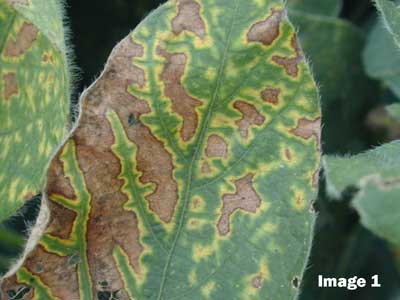
- Sudden Death Syndrome (SDS) infects soybean roots in the spring under cool, wet conditions.
- SDS infection may progress into conductive tissues when conditions are cool during flowering.
- SDS symptoms appear later in the growing season and include interveinal chlorosis/necrosis and distinctive blue colonies on the tap root.
- Yield loss impacts depend on timing, prevalence, and severity of infection.
- The only management options are preventive, including seed treatments and variety selection.
Sudden Death Syndrome (SDS) is caused by the fungus, Fusarium virguliforme. The life cycle of SDS is denoted by two distinct periods of infection of soybean roots in the early spring, followed by advanced disease development during flowering. SDS infects soybeans in the spring under the cool, wet soil conditions that are often associated with early planting. Infection is accentuated by the presence of soybean cyst nematodes, which injure the root system during feeding and create a point of entry for SDS infection, or may directly carry the fungus into the root on entry.
If conditions are relatively cool and wet during soybean flowering, the initial infection further develops and advances into the conductive tissues of the roots and lower stem. The fungus then produces a toxin that is translocated into the upper foliage, causing interveinal chlorosis and eventual necrosis (Figure 1). Visible symptoms typically appear in patchy distribution after flowering in July or August. The foliar symptoms are not distinct and may be confused with brown stem rot and other foliar diseases. Affected leaflets typically fall off, but the petioles remain attached to the stem. The stem pith remains white, but the cortical tissue may develop a faint grayish or tan discoloration, seen in cross-section or longitudinal slices (Figure 2). Diagnostic signs include the growth of blue-pigmented fungal colonies on the taproot surface just below the soil line (Figure 3).

SDS can cause premature defoliation and reduces photosynthetic surface area for pod fill, which leads to fewer and smaller seeds. Yield losses from SDS can be substantial and tend to increase with the following factors:
- History of SDS in the field
- Continuous soybeans
- Susceptible variety
- Early planting
- Compacted soils
- Cool, wet soils early, followed by cool period during flowering
- Presence of SCN
- Early appearance of foliar symptoms
Management of SDS is entirely preventive. No effective rescue treatments are available when foliar symptoms appear. Select a variety with known partial resistance to SDS. Short rotations of corn and soybeans may not reduce SDS pathogen load in subsequent soybean seasons, but research has shown that extending the rotation with cereal grain may help. Take steps to improve drainage and avoid compaction. Maintain optimal soil fertility. If planting early into fields with SDS history, use a preventive specialized seed treatment fungicide such as ILeVO™ (Bayer, fluopyram, group 7 SDHI). Take measures to manage and reduce SCN populations in the same fields. See your FS Crop Specialist to map out your SDS management game plan.
For further reading, please see the following:
Sudden Death Syndrome - CPN 1011 (Crop Protection Network, 2016)
Image 1: Interveinal necrosis foliar symptoms of SDS (Source: GROWMARK, Inc.)
Image 2: SDS symptoms in soybean stem. Note brown cortex, normal pith. (Source: GROWMARK, Inc.)
Image 3: Blue colonies of SDS fungus on soybean tap root (Source: GROWMARK, Inc.)
